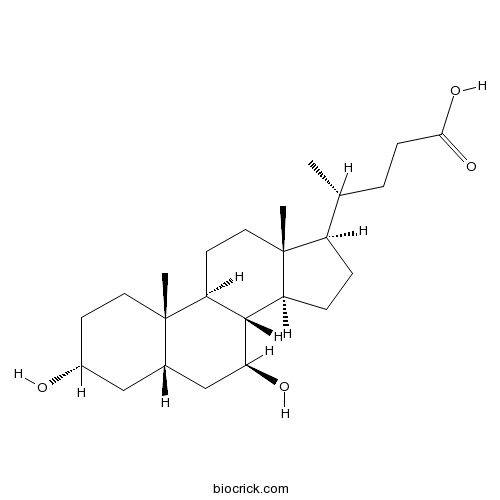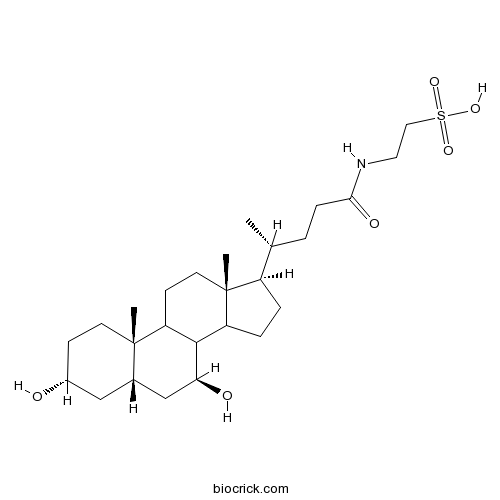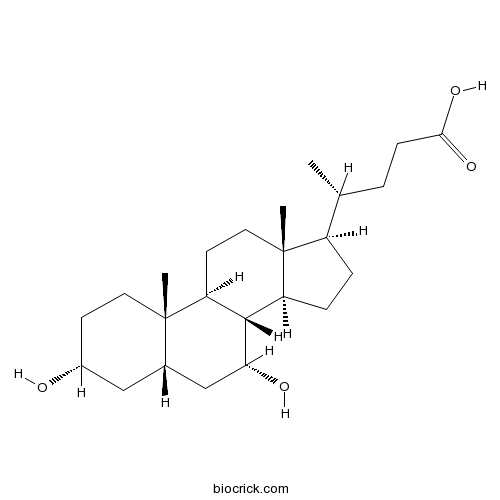Ursus thibetanus
Ursus thibetanus
1. The products in our compound library are selected from thousands of unique natural products; 2. It has the characteristics of diverse structure, diverse sources and wide coverage of activities; 3. Provide information on the activity of products from major journals, patents and research reports around the world, providing theoretical direction and research basis for further research and screening; 4. Free combination according to the type, source, target and disease of natural product; 5. The compound powder is placed in a covered tube and then discharged into a 10 x 10 cryostat; 6. Transport in ice pack or dry ice pack. Please store it at -20 °C as soon as possible after receiving the product, and use it as soon as possible after opening.
Natural products/compounds from Ursus thibetanus
- Cat.No. Product Name CAS Number COA
-
BCC4945
Ursodiol128-13-2
Instructions

-
BCN6953
Tauroursodeoxycholic acid14605-22-2
Instructions

-
BCN2620
Chenodeoxycholic acid474-25-9
Instructions

Cardiorespiratory effects of medetomidine and dexmedetomidine combined with tiletamine-zolazepam for the immobilization of Asiatic black bears (Ursus thibetanus) under isoflurane general anesthesia.[Pubmed: 30024923]
The aim of this paper was to compare the cardiorespiratory effects of the two combinations (medetomidine-tiletamine-zolazepam (MTZ) or dexmedetomidine-tiletamine-zolazepam (DTZ)) used for Asiatic black bear (Ursus thibetanus) immobilization. A retrospective analysis was carried out, reviewing the anesthetic records of captive bears. Sixty-six records were reviewed. The bears were immobilized, and general anesthesia was maintained with isoflurane vaporized in 100% oxygen. The mean sedation time and score were evaluated. The cardiorespiratory parameters were recorded every 10 minutes from intubation until extubation. Mean sedation time was 26.1 ± 14.5 minutes for the MTZ group and 25.6 ± 19.4 minutes for the DTZ group. The heart rate and the respiratory rate were higher in the bears immobilized with DTZ (66 ± 19 beats/min; 13 ± 5.2 breaths/min) as compared with the bears immobilized with MTZ (57 ± 14.5 beats/min; 10 ± 4.7 breaths/min) whereas the mean arterial pressure did not differ significantly between the groups. The body temperature was in the normal range throughout the procedures in all bears (MTZ 36.3 ± 0.9°C; DTZ 37 ± 1°C). In conclusion, the two protocols used in this study have been proven to be safe and reliable for the immobilization of Asiatic black bears, and the DTZ combination seemed to be associated with less cardiorespiratory depression than the MTZ one.
Seasonal variation of Cesium-137 concentration in Asian black bear (Ursus thibetanus) and wild boar (Sus scrofa) in Fukushima Prefecture, Japan.[Pubmed: 30020989]
To elucidate and reduce the risk of radionuclide contamination in wildlife caused by the Tokyo Electric Power Company Fukushima Dai-ichi Nuclear Power Station accident, it is important to understand radionuclide variations in the wild animal population. Here, we used environmental monitoring data and muscle samples collected from Asian black bear (Ursus thibetanus) and wild boar (Sus scrofa) from May 2011 to March 2016 to examine seasonal variation in radiocesium (137Cs) concentrations in muscle tissues (hereafter, muscle 137Cs) of these important game species in Fukushima Prefecture. We measured muscle 137Cs of bears and wild boars killed by hunters or in animal control culls. First, using a linear mixed model (LMM), we tested for a positive relationship between muscle 137Cs and 137Cs in the soil at the site of capture (hereafter, soil 137Cs) estimated from a soil 137Cs deposition map produced by the Japan Atomic Energy Agency. In the LMM, muscle 137Cs was positively related to estimated soil 137Cs, which corroborates the results of previous studies. The LMM regression coefficients differed between the two species, with wild boar muscle 137Cs being higher than that of bears sampled at the same locations. We then employed a generalized additive mixed model (GAMM) to estimate seasonal variation in the muscle 137Cs of the target species. GAMM showed that muscle 137Cs varied seasonally and that this seasonal variation also differed between the two species. In bears, muscle 137Cs decreased from spring to early autumn, before increasing in winter. Wild boar muscle 137Cs remained low during spring and summer and was high during autumn and early spring. These patterns are likely influenced by differences in diet, habitat use, and physiology between these two species.
Blood Chemistry Reference Values for Free-Ranging Asiatic Black Bears ( Ursus thibetanus) by Season, Age, and Sex.[Pubmed: 29671714]
Physiological characteristics, such as blood chemistry values, are valuable for evaluating the health of the animals. To our knowledge, these values have never been reported for the free-ranging Asiatic black bear ( Ursus thibetanus; ABB). Thus, 28 blood chemistry values from 50 free-ranging ABBs captured in Jirisan National Park, Republic of Korea, from 2005 to 2016 were evaluated. The aim of this study was to establish blood chemistry reference values for the free-ranging ABBs during both the hibernating and nonhibernating seasons. During hibernation, mean values of creatinine (CRE), total cholesterol, total protein (TP), albumin (ALB), triglycerides, and magnesium were significantly higher than those during nonhibernation; however, mean values of blood urea nitrogen, urea nitrogen to creatinine (U/C) ratio, inorganic phosphorous (IP), aspartate aminotransferase, alanine aminotransferase, gamma-glutamyl transferase, lactate dehydrogenase (LDH), high-density lipoprotein cholesterol, and alkaline phosphatase (ALP) were significantly lower. Age differences (young vs. adult) were found in IP, LDH, TP, and ALB values during hibernation and in the U/C ratio, calcium, IP, ALP, creatine kinase myocardial band, CRE, total bilirubin, and uric acid values during nonhibernation. However, there were no sex differences (male vs. female).
[Identification of bear bile powder and its adulterants by using DNA barcoding technology].[Pubmed: 29600635]
To identify the precious bile powder and its adulterants by DNA barcoding, and establish its standard experimental process to ensure the safe and effective utilization. Total twelve sequences from samples of bear bile powder which come from Ursus thibetanus for DNA extraction, PCR(polymerase chain reaction) and sequence, then using CodonCode Aligner V 7.0.1 shear primer region to obtain COI sequence. The COI sequences of U. arctos and their adulterants were obtained from GenBank. MEGA7.0 software was applied for analyzing mutation, calculating intraspecific and interspecific K2P(Kimura 2-Parameter) genetic distance and constructing the Neighbor-joining tree(NJ). The results showed that the maximum K2P genetic distance of bear bile powder of U. thibetanus and U. arctos are far less than minimum K2P genetic distance within its adulterants species, and the results of NJ tree demonstrated that each species could be distinguished from the counterfeits obviously. DNA barcoding is a safe, convenient and reliable technique for species identification, and it is important to establish the standard sequence of COI sequences for animal medicines.
Prevalence, genotypes, and risk factors of Enterocytozoon bieneusi in Asiatic black bear (Ursus thibetanus) in Yunnan Province, Southwestern China.[Pubmed: 29450634]
Microsporidiosis is an important zoonotic disease, even leading to severe diarrhea. However, no information about prevalence and genotypes of Enterocytozoon bieneusi infection in Asiatic black bears in southwestern China is available. The objectives of the present study were to investigate the prevalence of E. bieneusi and to characterize their genotypes using the nested PCR amplification of the internal transcribed spacer region of the ribosomal RNA gene cluster and multilocus sequence typing (MLST). The overall prevalence of E. bieneusi was 19.75% (80/405) and the rate of E. bieneusi in Xishuangbanna (33.33%) was significantly higher than that in any other regions (Honghe, 17.65%; Dehong, 13.04%; Kunming, 0; P = 0.01). Sequence analysis revealed that 4 known genotypes (D, n = 2; SC02, n = 10; SC01, n = 5; and CHB1, n = 4) and 13 novel genotypes (designed MJ1-MJ13) were identified. When 17, 5, 14, and 34 sequences at loci MS1, MS3, MS4, and MS7 via MLST analyses, representing 4, 4, 5, and 10 genotypes, respectively, were completed, one multilocus genotype (MLG novel-ABB1) was identified. This is the first report of E. bieneusi in Asiatic black bear in Yunnan province, Southwestern China. The results indicated the potential zoonotic risk of this parasite through the Asiatic black bear in this region and provided foundation data for preventing and controlling E. bieneusi infection of many other animals and humans in these regions.
Bamboo Specialists from Two Mammalian Orders (Primates, Carnivora) Share a High Number of Low-Abundance Gut Microbes.[Pubmed: 29188302]
Bamboo specialization is one of the most extreme examples of convergent herbivory, yet it is unclear how this specific high-fiber diet might selectively shape the composition of the gut microbiome compared to host phylogeny. To address these questions, we used deep sequencing to investigate the nature and comparative impact of phylogenetic and dietary selection for specific gut microbial membership in three bamboo specialists-the bamboo lemur (Hapalemur griseus, Primates: Lemuridae), giant panda (Ailuropoda melanoleuca, Carnivora: Ursidae), and red panda (Ailurus fulgens, Carnivora: Musteloideadae), as well as two phylogenetic controls-the ringtail lemur (Lemur catta) and the Asian black bear (Ursus thibetanus). We detected significantly higher Shannon diversity in the bamboo lemur (10.029) compared to both the giant panda (8.256; p = 0.0001936) and the red panda (6.484; p = 0.0000029). We also detected significantly enriched bacterial taxa that distinguished each species. Our results complement previous work in finding that phylogeny predominantly governs high-level microbiome community structure. However, we also find that 48 low-abundance OTUs are shared among bamboo specialists, compared to only 8 OTUs shared by the bamboo lemur and its sister species, the ringtail lemur (Lemur catta, a generalist). Our results suggest that deep sequencing is necessary to detect low-abundance bacterial OTUs, which may be specifically adapted to a high-fiber diet. These findings provide a more comprehensive framework for understanding the evolution and ecology of the microbiome as well as the host.
LAPAROSCOPIC-ASSISTED INSERTION OF A VENTRICULOPERITONEAL SHUNT IN A RESCUED ASIATIC BLACK BEAR (URSUS THIBETANUS) IN LAOS.[Pubmed: 28920775]
A 3-yr-old Asiatic black bear (Ursus thibetanus), weighing 68 kg, underwent a laparoscopic-assisted placement of a ventriculoperitoneal shunt for hydrocephalus in the Lao People's Democratic Republic. Rescued as a young cub with a notably domed head, the bear's condition had deteriorated with age, but euthanasia was not a viable option because of cultural issues. Surgery was attempted as a palliative measure. The bear had ventrally orientated crossed eyes (abducens nerve palsy and dorsal midbrain syndrome), papilledema, severe rhinorrhea, depressed mentation, lethargy, a very poor appetite, and was stunted. Hydrocephalus was confirmed via intraoperative 2.0-5.0 MHz head ultrasound, as no magnetic resonance imaging was available in the country. Surgery was planned via 3D modeling of museum skulls and brain cavity, and ultrasound examination of formalin-preserved brains of other carnivores with hydrocephalus. The bear demonstrated a notable improvement in mentation, appetite, and behavior, maintained for 4 yr following surgery.
Prediction of arterial blood gas values from venous blood gas values in Asiatic black bears (Ursus thibetanus) anesthetized with intramuscular medetomidine and zolazepam-tiletamine.[Pubmed: 28890467]
None


